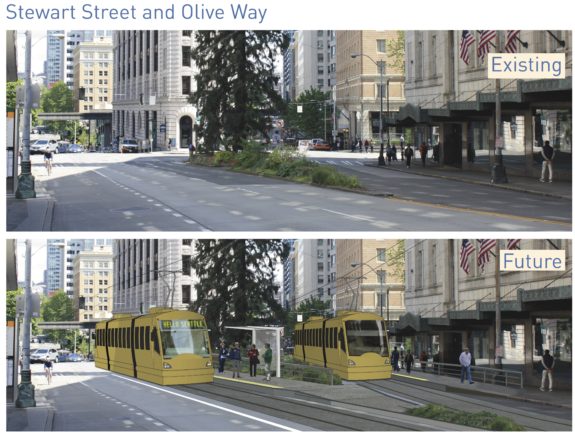Downtown streetcar plans would make 1st Ave, Stewart more dangerous for biking
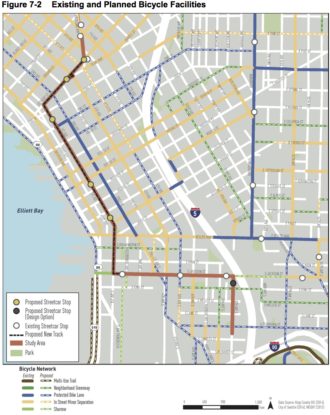
The proposed streetcar line imposed on a map of proposed downtown bike lanes, except with Stewart deleted.
Despite ample evidence that streetcar tracks injure and maybe even kill people biking, plans for a downtown streetcar line on 1st Ave and Stewart Street do not include any adjacent bike lanes or any other measure to make the tracks safer.
To put it bluntly, the $135 million Center City Connector Streetcar as currently planned would make downtown more dangerous for people on bikes than it is today. If constructed, people will be seriously injured or killed.
By providing no mitigation for the new biking dangers along its entire route, the plans also seem to disregard Seattle's complete streets ordinance requiring major projects to consider the needs of all road users. In fact, the project would even remove an existing (if substandard) bike route on Stewart.
To make matters worse, no mitigation for bike dangers was even studied in the otherwise exhaustive draft environmental assessment released recently. It's not as though bike lanes were studied and deemed impossible for this alignment. They weren't even studied. An investigation into options for making tracks safer for bike tires - including skinnier flange gaps and options for filling gaps - would also be good to add to the study (UPDATE: This brand new study (PDF) out of the UK is a treasure trove on the topic).
Instead, planners determined that the streetcar "would not affect bicycle access along First Avenue" because there are bike lanes on 2nd. This is maddening logic, especially for a street with as many businesses and destinations as 1st Ave. You have to bike on 1st to get to destinations on 1st. That should be obvious. So saying this streetcar would not affect bicycle access along 1st Ave is simply not true. It doesn't matter if 98 percent of a trip does not injure someone. It needs to be 100 percent.
SDOT consistently says that safety is the agency's top priority, and the city's Vision Zero policy calls for zero traffic deaths and serious injuries by 2030. Building a streetcar line that we know will cause injuries or death is in direct conflict with these policies.
Why build this streetcar?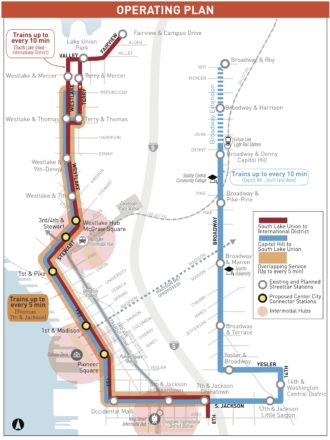
The red and blue lines combine for a streetcar every 5 minutes through downtown.
Before diving into the weeds on this project, I should note that I really want to like this streetcar. Its ridership numbers are much stronger than the existing streetcar lines, and it makes sense to actually connect those fledgling lines to make them more useful. Streetcars are also kinda cool, and I'm generally in favor of reallocating space on downtown streets to improve transit capacity and times.
And there are a lot of smart people working on this project. They understand that it not only needs to be efficient, but it also needs to provide a retail-level transit service to get people around downtown's neighborhoods as more homes and jobs are added.
I agree that the general 1st Ave/Stewart alignment was the best of the options studied initially. But only if it is safe.
And that's the problem. None of these benefits are worth harming people's lives.
1st Ave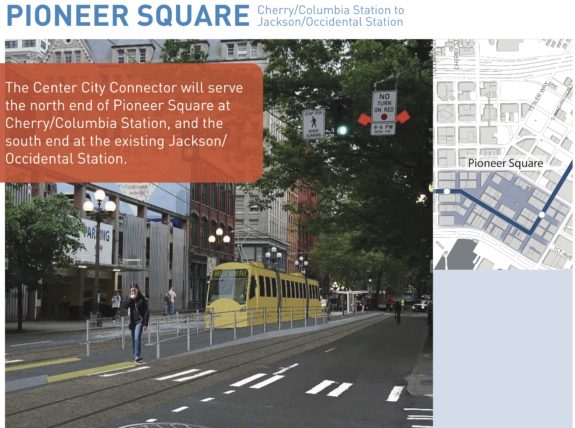
Note that even the planners' concept image shows someone biking on 1st Ave.
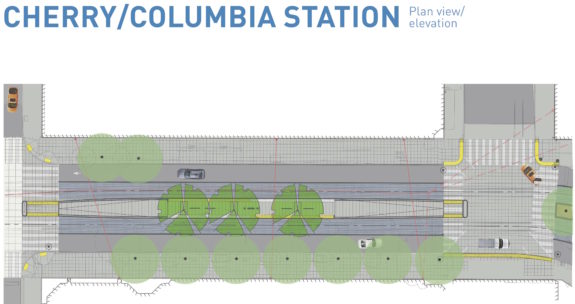 To get a sneak peek at the future of 1st Ave, just go down to Jackson Street in Pioneer Square during rush hour. This is essentially the exact same design as is planned for 1st Ave, except that the center streetcar lanes will be transit-only.
To get a sneak peek at the future of 1st Ave, just go down to Jackson Street in Pioneer Square during rush hour. This is essentially the exact same design as is planned for 1st Ave, except that the center streetcar lanes will be transit-only.
You will see lots of people biking precariously over the tracks. Only luck (and sometimes skill) keeps their tires from getting caught in or slipping on the metal rails. But sometimes, people aren't so lucky:
This crash resulted in a badly broken collar bone. It could have been far worse. The person biking, Seattle Neighborhood Greenways' Bob Edmiston, is experienced and knew to cross the tracks at close to a 90 degree angle. He just made a slight mistake and straightened out too soon, catching his rear wheel in the track. That's all it takes, especially when the tracks are wet (which is common in Seattle).
So one danger the tracks pose is for people turning on and off of the street like Bob was. Another common danger is caused when a vehicle or line of traffic is stopped or moving slowly in the right lane. People biking who attempt to pass are in danger of hitting the tracks.
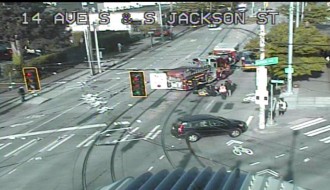
Traffic camera image from SDOT shows the emergency scene after Ahrendt's crash.
One year ago, Daniel Ahrendt was passing a bus on Jackson Street near Rainier Ave when his tire got caught in tracks, sending him crashing under the wheels of that bus. In May, Desiree McCloud was passing a friend on Yesler when the tracks may have caused her to crash. She passed away from her injuries a week and a half later.
The plans for 1st Ave do not mitigate these known dangers. The city can't repeat a dangerous design and expect different results.
Seattle Neighborhood Greenways is currently gathering signatures on a petition calling on the city to take swift action to fix dangers on Yesler Way and to create a policy for including protected bike lanes adjacent to all streetcar lines citywide. That certainly includes the Center City Connector.
As we wrote during early planning for this project in 2013 (comments that were apparently missed or ignored), the only solution is to build protected bike lanes adjacent to the tracks like on Broadway. In fact, project planners acknowledge as much in an appendix (caption theirs):
Of course, this isn't easy. One option would be to sacrifice the exclusive transit lanes and run the streetcars in mixed traffic instead. This is not good for transit times, and would likely reduce ridership. But it would preserve two-way traffic flow. Here's what that could look like, as Seattle Bike Blog mocked-up using Streetmix:
Our reasoning is that since 2nd Ave is southbound-only, 1st Ave is more important as a northbound corridor. And remember that the state is building a huge surface highway nearby on the waterfront, opening more options for people driving while degrading transit and walking.
Another option is to go all out and keep the exclusive lanes and the bikeway. Route southbound general traffic over to 2nd Ave or the new waterfront highway. The city could then make 1st Ave northbound-only:
 Or if business access is prioritized, restrict through-traffic like on 3rd Ave so people can only drive one block at a time. That way people can drive to access loading zones or parking garages, but shouldn't clog the streetcar lanes with traffic:
Or if business access is prioritized, restrict through-traffic like on 3rd Ave so people can only drive one block at a time. That way people can drive to access loading zones or parking garages, but shouldn't clog the streetcar lanes with traffic:

Streetmix has limits. Imagine that parking lane is a loading zone. And imagine the bike lane is raised to allow deliveries access to the sidewalk.
All these options would also dramatically improve the walking experience on 1st Ave since crossing distances would be much shorter and traffic levels much lower.
Stewart StreetStewart is even worse than 1st Ave because Stewart is a vital bike corridor. It's a rare street diagonal to the grid that connects various bike routes into (and, with a two-way bikeway, out of) downtown.
Stewart is marked with sharrows today, but the Roosevelt-to-Downtown High Capacity Transit project recently showed plans to add two-way protected bike lanes on Stewart.
Planning teams have apparently not been coordinating because the streetcar plans actually remove the bike route on Stewart and replace it with " nothing!
"Shared lane markings would be removed on Stewart Street between Sixth and First Avenue," the environmental study notes. "The elimination of these routes as designated bikeways would not have a major impact on bicyclist access because there is a comparable parallel route one block north of Stewart Street, on Virginia Street."
Not only does Virginia Street have no bike lanes (and this project is not proposing to add them), but it is also one-way in the opposite direction. And unlike Stewart, Virginia does not connect to Eastlake Ave E, a major bike route. And to make matters worse, Virginia has a very dangerous crossing of - you guessed it - the existing streetcar tracks on Westlake Ave.
This project must install protected bike lanes on Stewart. It's the only option that is safe. And a different SDOT project is already planning one, so this isn't just some bike blog saying this.
Here's the Center City Streetcar design for Stewart:
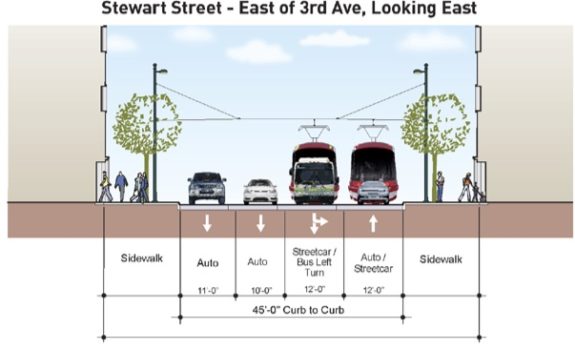 And here's the Roosevelt-to-Downtown project's design for Stewart:
And here's the Roosevelt-to-Downtown project's design for Stewart:
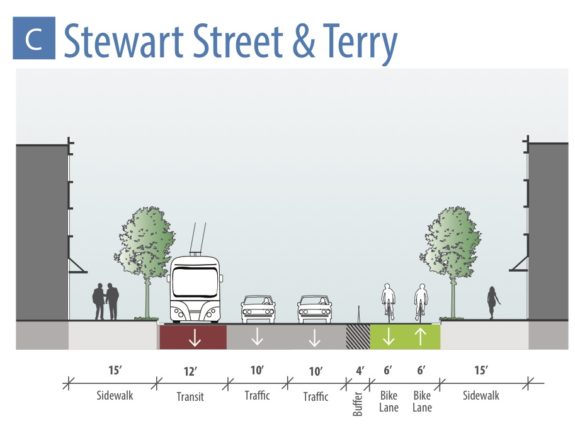 There is plenty of space on Stewart for transit lanes and bike lanes. It just may require removing general purpose lanes or turn lanes. But removing the bike lanes is not an option because that is a recipe for serious injury or death.
There is plenty of space on Stewart for transit lanes and bike lanes. It just may require removing general purpose lanes or turn lanes. But removing the bike lanes is not an option because that is a recipe for serious injury or death.
Safety is the top priority. Period.
The streetcar team also needs to rethink the intersection with Olive (see photos at top) because their current design leaves no space for people who will inevitably bike that way.
ConclusionIt's disappointing that bike safety was not included more significantly in this study and in the designs. These issues were raised early in the design process and were apparently disregarded. So now we're in a place where big design changes are needed after all this environmental study has been completed.
Without a safe plan, this project is probably going to face direct and loud opposition from safe streets advocates. And with support for streetcars already fairly weak in this town, I don't see how they can weather safe streets opposition as well. Who is left supporting it? The safe streets movement is organized and willing to show up and be loud if that's what it takes.
On the flip side, if this project included big improvements to safety and walk/bike mobility, it could have the enthusiastic support of safe streets advocates instead. I would much rather support something representing a bold walk/bike/transit vision for downtown than oppose this streetcar.
This is just the draft environmental assessment. So the team has a lot of work ahead of them before releasing the final version.
Comments can be emailed to centercitystreetcar@seattle.gov.
